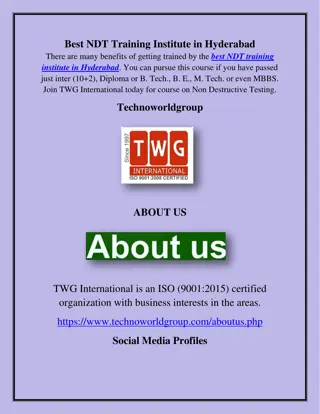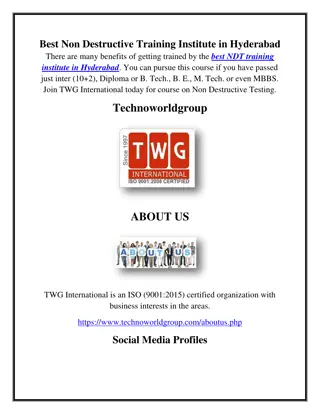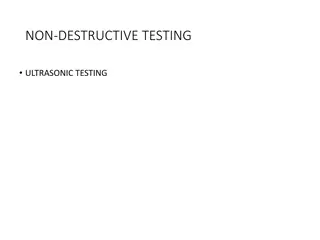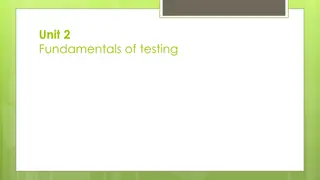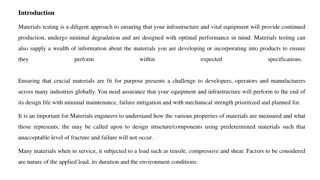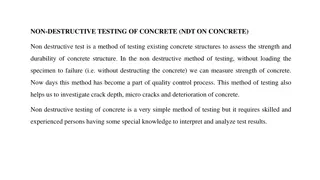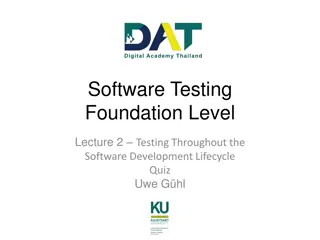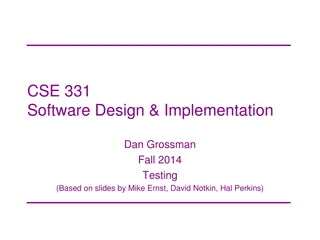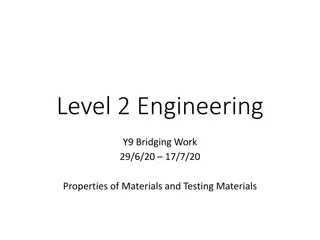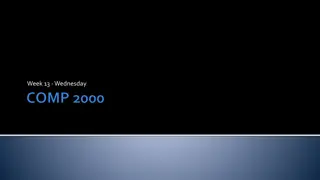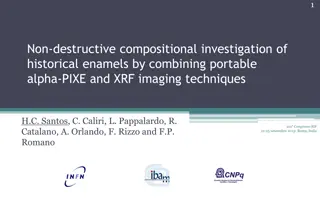Non-Destructive Testing (NDT) Module 1
Non-Destructive Testing (NDT) is a vital analysis technique used in various industries to evaluate material properties without causing damage. NDT methods like visual inspection, liquid penetrant, magnetic particle, ultrasonic imaging, eddy current testing, and radiographic inspection play a crucial role in ensuring the integrity of materials and components. This module provides an overview of NDT and its importance in product evaluation, troubleshooting, and research.
Download Presentation

Please find below an Image/Link to download the presentation.
The content on the website is provided AS IS for your information and personal use only. It may not be sold, licensed, or shared on other websites without obtaining consent from the author.If you encounter any issues during the download, it is possible that the publisher has removed the file from their server.
You are allowed to download the files provided on this website for personal or commercial use, subject to the condition that they are used lawfully. All files are the property of their respective owners.
The content on the website is provided AS IS for your information and personal use only. It may not be sold, licensed, or shared on other websites without obtaining consent from the author.
E N D
Presentation Transcript
Non-Destructive Testing (NDT) Module 1 Rahul Singh Assistant Professor Department of Mechanical Engineering 1
Introduction to NDT Nondestructive testing or non-destructive testing (NDT) is a wide group of analysis techniques used in science and technology industry to evaluate the properties of a material, component or system without causing damage.The terms nondestructive examination (NDE), nondestructive inspection (NDI), and nondestructive evaluation (NDE) are also commonly used to describe this technology.Because NDT does not permanently alter the article being inspected, it is a highly valuable technique that can save both money and time in product evaluation, troubleshooting, and research 2
Non-Destructive Testing (NDT) Non-Destructive testing is the use of noninvasive techniques to determine the integrity of a material, component or structure or quantitatively measure some characteristics of an object. It is the testing of materials, for surface or internal flaws metallurgical condition, without interfering in any way with the integrity of the material or its suitability for service. or i.e. Inspect or measure without doing harm. 3 T
Six Most Common NDT Methods Visual Liquid Penetrant Magnetic Ultrasonic Eddy Current X-ray 4 Hareesh k,AP,Dept of ME,VAST
1. Visual Inspection 5 Hareesh k,AP,Dept of ME,VAST
2.Liquid Penetrant Inspection 6 Hareesh k,AP,Dept of ME,VAST Downloaded from Ktunotes.in
5.Eddy Current Testing Coil's magnetic field Coil Eddy current's magnetic field Eddy currents Conductive material 9 Hareesh k,AP,Dept of ME,VAST Downloaded from Ktunotes.in
Comparison Between Destructive and Non Destructive Testing 11
Importance of NDT 1. NDT increases the safety and reliability of the product during operation. 2. It decreases the cost of the product by reducing scrap and conserving materials, labor and energy. 3. It enhances the reputation of the manufacturer as a producer of quality goods. All of the above factors boost the sales of the product which bring more economical benefits for the manufacturer. 4. NDT is also used widely for routine or periodic determination of quality of the plants and structures during service. 5. This not only increases the safety of operation but also eliminates any forced shut down of the plants. 12
Scope of NDT Non-destructive testing is a descriptive term used for the examination of materials and components in such a way that allows materials to be examined without changing or destroying their usefulness. NDT or NDE can be used to find, size and locate surface and subsurface flaws and defects. NDT plays a crucial role in everyday life and is necessary to assure safety and reliability. Typical examples are found in aircraft, spacecraft (shuttle), motor vehicles, pipelines, bridges, trains, power stations, refineries, buildings and oil platforms which are all inspected using NDT. NDT is a Quality Assurance management tool which can give impressive results when used correctly. It requires an understanding of the various methods available, their capabilities and limitations, knowledge of the relevant standards and specifications for performing the tests 13
Scope of NDT Cont.. NDT is used typically for the following reasons: Accident prevention and to reduce costs To improve product reliability To determine acceptance to a given requirement To give information on repair criteria. 14
Difficulties in NDT However lack of skilled operators, an aging workforce and cost conscious users are key challenge faced by Non Destructive testing market. Though development in infrastructure and power generation have incrementally increased demand for new operators but shortage of supply and shrinking budget continues to 15
Future Progress in NDT 3D characterisation Ultrasound is the ideal vehicle for exploring the local response of a composite structure to stress, and map this across the whole 3D structure Mechanical Modelling Using NDT Data Recent developments in X-ray CT and ultrasonic 3D characterisation of composites offer the potential for a greater understanding of the effects on structural integrity of material variations such as in-plane fibre waviness, out-of-plane ply wrinkling, and 3D variations in fibre-volume fraction or porosity 16
Economic Aspects of NDT It is highly Economical compared to other methods. Products can be reused Rejection rate is less 17
Visual Inspection Most basic and common inspection method. Portable video inspection unit with zoom allows inspection of large tanks and vessels, railroad tank cars, sewer lines. Robotic crawlers permit observation in hazardous or tight areas, such as air ducts, reactors, pipelines. 19 T
Visual Inspection Visual Inspection is one of the most widely used Non-Destructive Testing methods for the detection of discontinuities before they cause major problems, e.g. poor welding, surface defects, corrosion pits, general condition, degradation, blockages and foreign materials. 20
Visual Inspection means the inspection of equipment and structures using a combination of human senses such as vision, hearing, touch and smell. Visual Inspection is sometimes carried out in conjunction with devices such as a low power magnifying glass, boroscopes, fiberscopes, digital video borescopes, camera systems and robotic crawler systems. 21
Generally, almost any specimen can be visually examined to determine the accuracy of its fabrication. For example, visual inspection can be used to determine whether the part was fabricated to the correct size, whether the part is complete, or whether all of the parts have been appropriately incorporated into the device. 22
Vision The eye Human eye is the most valuable NDT Tool Sensitivity of the human eye varies according to the light source Human eye has an excellent visual perception Yellow green light of wavelength 5560 A is the most suitable light for human eye at normal condition 23
Tools Used in Visual Inspection Mirrors Magnifying Glasses Microscopes Borescope Endoscope Flexible fibres Closed circuit Television system Computer enhanced systems 24
Applications of Visual Inspection It is used to inspect whether there is a misalignment of parts in the equipment It checks for corrosion, erosion, cracks and deformities of machine components It inspect the plant components for any leakage or abnormal operation It is used to identify the defects in weldments 25
Limitations of Visual Inspections Can identify only large discontinuities Limited to surface discontinuities Skilled labour required Result depend on the eye resolution of the inspector It may cause eye fatigue to the inspector 26
Lighting and Lighting source The amount of light is depend up on the type of test. For an appropriate visual inspection, suitable lighting of about 800-1000 Lux The major lighting sources are Incandescent Lamp Fluorescent lamp High intensity discharge lamp 27
Material factors that affect Visual Testing Environmental Factors Atmosphere Cleanliness Humidity and Temperature Safety Physiological Factors Physical Comfort Health , mental attitude, fatigue and test item position Surface Condition Cleanliness Colour Texture Physical Conditions Specimen Condition Shape and Size Temperature 28
Types of Visual Inspection 1. Unaided Visual Inspection 2.Aided Visual Inspection 29
1. Unaided Visual Inspection It is also Known as Direct Visual Inspection It can be accomplished with the help of naked eye It can done with out the help of optical aids Defects can be detected are Absence of cracks, Corrosion layer, surface porosity, Misalignment of mated parts 30
2. Aided Visual Inspection It is also known as Indirect Visual Inspection It is performed using optical instruments This will identify the defects which cannot detect with human eye It permits visibility to areas are not accessible to human eye 31
Visual Perception It is the interpretation of impressions transmitted from retina of eye to the brain in terms of information Visual perception depends on the vision acuity Human eye has an excellent visual perception 32
Tools Used in Visual Inspection Mirrors Magnifying Glasses Microscopes Borescope Endoscope Flexible fibres Closed circuit Television system Computer enhanced systems 33
Magnifying Mirrors It is also known as concave spherical mirrors It is used to magnify the areas which are not accessible to human eye. 34
Magnifying Glass It is also called as Hand Lens This lens is used to produce a magnified Image Magnification depends upon the position where it is being placed between the human eye and the object For higher power magnification, double or multiple lenses are used 35 Hareesh k,AP,Dept of ME,VAST
Microscope Microscope is used to magnify the image of a small object Magnification Power = 10/F 36
Borescope Which is used to inspect the inside of a narrow tube It is a flexible tube with an eyepiece at one end and objective lens at another end Light is passed through the lens and to obtain a clear image Available range is 2.5 mm to 19 mm Video 37
Endoscope It is bit superior than borescope Magnification factor of 10X is obtained Available up to smaller dia of 1.7 mm and length upto 100-150mm
Fibroscopes Also called fibre optic borescope Dia range of about 3 to 12.5mm and length varies between 60 365 cm 39
Special Lighting Back Lighting Front Lighting Structured Lighting Strobe Lighting Ultraviolet Lighting 41



